
Neck Sharpies: 404 Found or How to Use Woody Hayes to Beat the Bucks

Fielding Yost had a problem. After four years of dominating college football many other teams had learned his speed-'em-up and spread-'em-out offense, and were coming up with new ways to use the attack. Single-wing football was taking over, and the old way of matching seven players on the offensive line with seven defensive linemen was starting to get run around.
The guy who solved it for him was center Adolf "Germany" Schulz. Rather than limit himself to taking on interior linemen when the ball kept going outside, Schulz stepped back, ready to launch himself back at the interior if need be:
If you're wondering where's the safety, he had to hang way back in case the offense punted.
It wouldn't be the last time defenses learned to counter offensive innovations by pulling back box defenders.
S/O to Iowa State for finishing 22nd in the country in Rushing S&P+ while employing a 4 man box as often as possible. pic.twitter.com/iwrd1BfsfN
— Seth Galina (@SethGalina) May 8, 2018
As forward passing took hold, Crisler and his contemporaries began playing with lighter guards they could move off the line as a third linebacker. When teams starting regularly splitting ends out as wide receivers, Bump had to turn one of those linebackers into a second safety. As the I-formation took hold Bo had to replace his ends with OLBs to match their speed to outside runs. As shotgun three-wides became the norm, so did fifth defensive backs like Don Brown's Viper. And if you think it stops there, you're still living in the 2010s.
click for big
Michigan's 4-2-5 defense was good enough to match up with most of their schedule, but you don't need to be reminded of the times when it got got. You recall Saquon Barkley on McCray. You remember Devin Gil hopelessly chasing Ohio State's scatback DeMario McCall. You probably remember Florida quarterback Feleipe Franks running into acres of space. And if your lizard brain didn't go to "RECRUIT HARDER!" you've probably begun to understand what that signifies: The reign of nickels is over. The time of the dime has arrived.
[After THE JUMP: Why elite spread offenses torch us, and how we can use Woody Hayes's defense to stop it]
------------------------------------
Feleipe Franks Running Into Acres of Space
This is only news up here in the Big Ten. The Big XII has been living in a world of four- and five-wides for quite some time. While offenses still generally start with "11" (one back, one TE) on the field, most teams now carry at least one back who can double as a slot bug, while tight ends are getting on the field well before they hit a plausible weight for blocking, because you don't have to weight 240 to split out into the slot as a jumbo receiver.
Doing so screws with Michigan's defense. The way the base Cover 1 they run is structured, every Michigan defender should be able to cancel out the guy across from him: corners for receivers, a slot safety for slots, a Viper for tight ends, and linebackers for running backs, with a little left over up front to lend an assist. That leaves a safety to roam deep and help on in-breaking routes, and a linebacker free to cover an extra zone or blitz.
But when Florida went five-wide with their base personnel, it pulled the personnel away from the jobs they were recruited to do, and a simple QB zone run turns into a disaster:
Michigan's DTs both didn't do very well here. Kemp got himself scooped and sealed by the guard and center, allowing the center to get out and harass Kinnel into taking one side of the center with nobody left to take the other. Dwumfour got too far upfield, widening the gap for Franks to run through when it's his job to squeeze it smaller:
Since these are the projected starting tackles this year this isn't a problem that's going away. The issue here though is Florida coach Dan Mullen has removed all sorts of run defenders who would normally be in a situation to come off their guys and help. Let's check in on our nominal front six and see what they're up to:
| Player | Matchup | Role | This Play | Result |
|---|---|---|---|---|
| Kemp (N) | C/G | Close A gaps | Close A gaps vs C/G | Bad-2 |
| Dwumfour (T) | G | Attack B, squeeze A | Attack B, squeeze A | Bad-.5 |
| Winovich (A) | T | Attack C, slow TE release | Atttack edge, squeeze B gap | nil |
| Uche (E) | T | Set edge/rush | Attack edge | nil |
| Ross (M) | RB | Stop RB/QB | Edge CB/RB man | nil |
| Hudson (V) | TE | Cover TE, set edge | Edge CB/TE man | nil |
They've got Tyree Kinnel playing linebacker behind the front four. Where are the real linebackers? Waaay outside, playing man to man on the tight end and running back. That's okay if everyone does their jobs, but not the structure of the defense. The structure of the defense has Hudson in a spot where he can read run and take the edge off Winovich's plate. It has Ross in a spot where he's watching the ball and can go after it. It also has Winovich (as the Anchor here) in a place where he can affect inside runs because Hudson's around.
Modern offense is all about pulling material away from where the ball's going. We've been going over how Gattis does that all offseason. Here's us getting Gattis'd. All the help got yanked as far as possible from the play, a few guys screwed up, Metellus decided the four receivers bunched to his side were more deserving of his attention, and Florida got themselves an easy six.
How Bump Elliott & Woody Hayes Solved It
This resonates with developments back in the 1950 and '60s. At first the wide receivers were just the same tight ends and running backs who were on the field for the base running plays.
Wingbacks were 75% running backs and 25% tight ends. Tight ends were tight ends. But as they spent more time split wide they became specialty times. "Flankers" were running back-like wide receivers; and "Split Ends" were tight end-like wide receivers. For a short time, some defensive coaches (notably, Barry Switzer at Oklahoma) kept their ends on ends, but that became less sustainable as split ends turned into wide receivers and defensive ends remained, essentially, linemen.
Splitting out like that however took away other guys who'd been involved in run stops. Defensive halfbacks used to have a role more like Khaleke Hudson's. They set the edge, freeing the ends to try to bend around and cause pressure. Forced way out wide, those halfbacks could no longer help much in run D; they were in fact well on their way to becoming the modern cornerback. They also could no longer help with any tight ends or backs who released into routes. Look at that setup above and you tell me: who's covering the TE on the left? Now look at the setups below:
What needed to be done was obvious. The defensive philosophy of the 5-3 was everybody in the defensive front has a man, with one roving free to track down the running back. So the front 7's free hitter was pulled out of the box for an extra defensive back who could do all the things the halfbacks used to. They had all sorts of great names—wolfman was ours—as occurs when there's a new hybridization, but this position ultimately became the strong safety.
That took care of the passing, but necessitated a change in philosophy, since there were no more free hitters. From the time of Germany Schulz (it was his idea) defensive players generally lined up off the outside shoulder of their counterparts, using the leverage gained by that to insert himself in the outside gap and shove the inside gap closed using the body of his blocker. Both solutions in the 5-2, in trying to preserve what their coaches liked best about 5-3 philosophy, hit upon the same idea: move in the tackles.
The "Oklahoma" wanted to keep individual matchups: my guy on your guy. The three interior DL would be right on top of their counterparts and try to cover multiple gaps by owning the player. This freed up the ends to do all sorts of fun things when a TE wasn't there, like scream after the quarterback or drop into coverage. Ultimately the ends got replaced by linebackers, and the Oklahoma 5-2 became what we know as the 3-4. This became Bump Elliott's base defense (Bo used a 5-2 formation but his "angle" defense was unique).
The "Eagle" tried to win back a free hitter by focusing more on gaps, having one guy take two so the others could play their gaps aggressively. The first step was to move in the tackles.
Keep going.
Keep coming.
Stop there—on the inside shoulders of the offensive tackles. There they could control those B gaps that most running games were built to attack. The middle guard would control both A gaps by beating the center (usually the smallest and weakest of the offensive linemen), one gap would go to a linebacker, and the last linebacker was again freed to go hunting. It worked beautifully, allowing the defenders to shoot their gaps aggressively instead of worrying about where the play was going, since that was the free linebacker's job. And it allowed them to keep that hybrid linebacker/safety over a tight end.
Eagle defenses also learned they could move the middle guard off the line a bit to mess up blocking angles and give him a second to choose where to attack.
Here we see the origins of the 4-3, which moved that middle guard back to a third linebacker and shifted the front around. As offenses adapted to run more off-tackle, Eagle teams could shift their front to the frontside: the 5-2 Double Eagle. These ultimately evolved into the 4-3 and 4-3 under, each with variations on a 1-tech, 3-tech, 5-tech, and an edge. But if you wind back the clock to the original Eagle we find a very similar front to the one Iowa State was in at the top of the post:
And in case you're wondering if Woody Hayes's Double Eagle variant is used today: it is! I was watching the Army defense—one of the first Tite adopters—a few weeks ago for HTTV and noticed they were having the nose sometimes step off a yard then shoot into the backside A-gap. When I pinged Ian Boyd about this he confirmed:
And Cody Alexander even called the Tite front the "New age Double Eagle."
Spread Teams Hate It So So Much
Alexander also focused on how the Tite messes with the base plays of spread football:
The modern Spread offense is based on two primary plays: the inside and outside zone, plus the reads and RPO’s that go along with them. Many offenses choose to add gap plays, but the Spread offense is predicated on the cutback….
In this day and age, the great defensive minds are turning disadvantages into their own advantage. If a team is zone heavy, why not plug the middle and force the cutback early, if not drastically? Most high school and college Spread offenses rely on speedy backs to run the ball outside or cut it all the way to the backside once the over pursuit has been walled. Many Spread formations force the defense into light boxes that Spread teams feast on. Again, why not make that an advantage for the defense? The 3-4 Tite Front can be a simple way to eliminate the inside zone, make zone reads harder for the QB, and force the teams that like to run a zone offense to bounce their plays outside to open defenders.
The "404" is a bit confusing as a name because in the 3-4/4-3 era we all learned to use "30" to mean three-man fronts and "40" to mean four-man fronts. The 404 here refers to where the three defensive linemen are aligning. Remember the weird numbering system for "techniques" on the defensive line:
That's what they mean here: two guys in a 4i-technique flanking a nose tackle in a 0-tech. Boyd's article on the 404 Tite front is going to be required reading as dime defense becomes the norm up here, so let's link and quote it now:
With the DEs sitting in position to handle the B-gaps, the defense then has three guys positioned between the tackles to handle the two remaining A-gaps. The nose will typically lock one down while one LB will be able to take the other while the other is freed up to key the ball or take on an insert block. What’s more, not only is the defense well positioned to defend all the gaps between the tackles but two of the five guys up front are off the line and thus “moving targets” for the offense to try and block.
The positioning of the linebackers and of the DEs makes life very difficult for offenses trying to execute spread run game favorites.
The "spread run game favorites" he's referring to are inside zone runs, including zone read, split zone, belly, etc. They've learned to look for and emphasize runs into those 'B' gaps, recruited tackles who are good at getting out into space and heavy guards who are good at pushing 300-pound DTs out of the way. One of the reasons the 404 has been successful is it swaps that paradigm (sorry if it's upside down):
All of the good rules of thumb for zone running become bad ones. Edge defenders are harder to find, let alone option. Power running teams have a hard time finding anybody free to from the backside, since you don't want to remove someone with lineman off his shoulder and the tackle is a bit too far away to help. RPOs designed to attack run/pass linebackers are no longer pass reads because that guy's not there.
And most importantly the defense can get away with another hybrid in place of a defensive lineman, so the defense doesn't have to keep specific players matched up all the time. If they want to take you wide, you've got versatile defenders all over the place who can handle that, while your run-stoppers stay home.
Drawbacks
SBNation's Seth Galina spelled out how it solves the RPO problems for backside defenders.
THe Tite front eliminates this perpetual conflict for linebackers.
In a Tite front, there are no open B gaps. The gaps that are open are the C gaps (outside the offensive tackles), but, again, defenses are fine with the ball-carrier having to run east-west before turning his shoulders and dashing to the end zone. Linebackers can be a little more passive and less committal as they wait for the ball to go downhill.
One of the most interesting parts of the Tite front has been the hybridization the edge rusher. When defensive coordinator Dave Aranda arrived at LSU for the 2016 season, he inherited Arden Key, a stellar defensive end. With his length and size, Key became a standup outside linebacker who could rush the passer or drop into coverage, based on the call.
Running off-tackle and the front-side A gap are now back on the menu. But with all kinds of speed on the edges these days, defenses will take a ballcarrier with his shoulders pointed to the sideline a win. And three yards and a could of dust in the context of what modern offenses put up doesn't sound very sexy. As they quickly learned in the 1960s, if an offense's center can create space on your nose tackle all by himself, the linebacker help can't get there until the could of dust is already dissipating.
The bigger drawback is you're giving up those pass-rushing DEs. With nickel defenses all the rage, dropback passing doesn't happen very much anymore—Rashan and Chase put a definite timer on anyone who tried. Khaleke and Glasgow would certainly be involved in pass rushing instead, but it's not the same thing.
Another drawback is those hybrids have to be in some kind of zone defense, since they're now your run/pass conflict defenders. In the context of RPOs, that's not a bad thing, since these hybrids are best at hanging back in a passing lane then shooting up to make a stop. It's what safeties do best. In the context of Michigan's defense, it's fine: they often had Khaleke or Peppers in zone anyway.
And finally, it's supposedly not very strong against Power Read/Inverted Veer—that play Ohio State really loved to run in the mid-aughts.
Don Brown's way of dealing with this was a kind of scrape exchange between the DE and Viper, where the DE would crash down and get replaced as an edge defender by the hybrid linebacker behind him. OSU's adjustment was to trap block, and that ended hilariously against Michigan when Taco Charlton deposited said trap blocker in J.T. Barrett's lap. That DE is no longer available—if a linebacker has to come up and set the edge, he's going to get wrecked against a pulling guard or tight end.
However the one time I've seen Power Read run against a Tite-like formation was it was a 3rd and 1, and ended up as a four-yard loss. It's also one of the only Tite-like plays I've seen Michigan run. I keep saying "Tite-ish" because Brown only ran it as a changeup with his base 4-2-5 personnel, taking advantage of the fact that Rash Gary can move like a linebacker and Devin Bush can move like a hybrid space player.
This play was from last year, and since it was right before The Game I don't doubt they were preparing it for Urban. I don't know if IU had an RPO read on this one but Metellus shoots up when he sees the quarterback tuck it:
If Metellus doesn't have eyes in the backfield he can't help on the edge there. Bush had the tight end beat and probably ends this himself if they're just playing their regular 4-2-5 cover 1, but we don't get to have Devin Bush Jr. anymore, and asking a guy to do Devin Bush Jr. things in the 2020s is just asking for it.
We also don't have anymore Rashan Garys. It's easier to find safeties. But picture the above with Hudson in Bush's spot, a free safety in Hudson's spot, and another hybrid where Kinnel was, and you can see the Tite. Stuff like this has been in the playbook for awhile, but usually only comes out for special occasions:
Including one time they went with basically a Double-Eagle:
It's never been more than that.
The Case for Michigan to Go Tite
The personnel available this year might be a better fit for a base 3-2-6 dime than for a 4-2-5 nickel. Some benefits we might be interested in:
- One DT on the field instead of two of Dwumfour/Kemp/Jeter
- Michigan has two experienced DEs who can play a B gap but aren't great pass rushers in Kwity and Hutchinson, versus a grad transfer from CMU and a guy who's been injured the last two years who can pass rush but might not hold up in a B gap.
- Michigan has two good vipers in Khaleke and Glasgow, and a lot of safeties who'd like to play it.
- Nothing matters this season but beating Ohio State, a modern spread that likes to use its RBs as extra receivers.
I'm not saying it has to be their base defense—the 5-2 era still saw plenty of 5-3 and 6-2 (which returned in the 1980s as the 46 Bear), just as we still have a use for 4-3 and 4-4 personnel today. In fact Michigan can probably get through most of their schedule this year in that base 4-2-5. But I would like to see them have the Tite in their back pocket to use against Notre Dame and Ohio State, including blitzes that neither rival has seen.
I'm sure I'll go back through it and read it a few more times to really get into the weeds of this, but the level of detail and depth that goes into these things is astounding.
Football Study Hall wrote about Big 12 dime defenses a couple of seasons ago:
https://www.footballstudyhall.com/2017/11/3/16599180/why-dime-is-now-base-defense-in-the-big-12
And they've been stuffing the spread for how long?
Maybe not fair, but other than Iowa State, TCU, and maybe Texas (which flat out has players) there just isn't any defense over there I'd remotely look at as a model for how to get it done on the defensive side of the ball.
Iowa State and TCU care about defense and it shows on Saturdays. Scheme is important, but it's also coaching, skill development, tackling, and actually having a head coach that gives a fuck about the other side of the ball.
Texas Tech and Oklahoma don't give a rat's ass about defense and it shows on Saturdays. They might have some good scheme stuff, but it's completely overshadowed by being treated as 2nd class citizens on their own damn team. There's no skill development, most everyone looks confused and they can't tackle anyone. And Oklahoma doesn't have any recruiting excuses.
Awesome! I love to read about the history and evolution of the offensive vs. defensive schemes arms race. Thank you for analyzing the process and applying to our team--makes for a fascinating read, at least for me. Side note: if you ever decide to write a book on the evolution of football strategy and say, oh I dunno, put it on Kickstarter, I will definitely buy it!
The depth and support you have is astonishing. Especially, how you inserted Woody as a coach that solved for modern offenses during his time. Hell of connection.
These are some of my favorite posts, but this one was so deep that I just feel like Chevy Chase from Three Amigos laughing and smiling when he doesn't understand what just went over his head (the "male plane" joke, IIRC).
I mean... I like where this is going and it's well-written but... *whoosh*
Thanks for another excellent post Seth. This type of tactical depth and the constant evolution of football strategy makes it the greatest game there is.
Love the information and the breakdowns! But the 5-2 Oklahoma graphic only has 10 defensive players in it.
Safety. Field position was so important back then that if you didn't leave a safety at punt depth they'd just punt it and you'd watch helplessly as all the precious yards you'd spent all quarter obtaining dribbled away with the rolling ball.
I had read the part about the super deep safety, and then promptly forgotten about it by the time I made it there...my bad.
Safety first...... always Safety first.
Great write up. Thank you. Did Narduzzi use the 404 front against Rich Rod and Hoke era Michigan teams? All I remember from those seven years were the A-gap blitz by the line backers! Shiver me timbers!!
Maybe in the course of tooling around with pass rush formations? VT went full Bear defense one time against Ohio State, putting DL over both OTs and covering the B gaps. That initiated the Ohio State power read era.
But the tite as a base defense and pretty new. There's a huge difference between doing something weird that surprises the other team, and putting a base on film that the other team will prepare for while preparing for you. It has to work against counters or you can't use it.
Looking at the 404 and how its weak against that power read...wouldnt is also be weak against pin and pull or really any play where the offense is outflanking you?
With only 3 linemen and two in the 4i, they are asking to be pinned.
Yes depending on that center-NT matchup. Pin & Pull schemes don't like a nose head up unless they're confident the center can seal that guy. If he can't you've got to pin with the frontside guard and pull the center. When Michigan runs their Down G stuff they almost always ask the center to reach a nose over him because you want that frontside guard pulling.
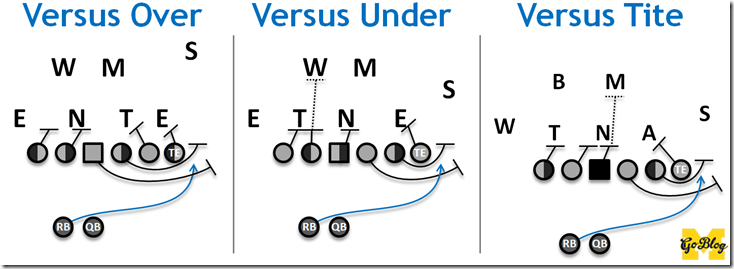
I started getting into that and realized this was way too in the weeds and Michigan's the only big pin & pull offense right now.
I'm not trying to demand more free content, but I would love an off season* podcast further detailing neck sharpies/scheme in general.
*I understand putting this together during season would basically be impossible.
It'd have to be video. NO WAY can I explain this stuff with just words.
I would also accept an MGoBlog video presentation. I didnt want to be greedy.
Good shit, Seth.
Run midline or trap to either side.
No doubt. I was thinking the same thing. That D formation is a wet dream for a team that can trap inside & run midline.
YUUUPPPP. That's why ISU just starting having the NT fill the backside A and the linebacker take the other A. Midline and traps are fine until the nose is all up in your shit before you've even got the ball handed off.
Sigh. . . I miss Mo Hurst.
Well in this case the nose would be doubled, so not an issue IMO.
You are absolutely right.
But how many teams run trap (or midline) anymore as a base play, much less a changeup?
It's a good defense against most base spread run games.
Also, both take a little too long if not under center.
I agree with all of your reasons why Michigan should use more 3 man fronts in general, more speed on the field, less bodies on the line. Not to mention DT is a real issue, and DE is a strength even after losing two to the NFL.
That said, I wish you would purge Florida from your memory banks. When Franks ran it up the gut one play and I noticed on the replay it was Kinnel in the box instead of Ross I couldn't believe it. Next time Florida lined up the same way and Ross split out wide I thought "did we learn NOTHING from getting 62 points dropped on us by the Buckeyes? Nothing?", and stopped watching.
If you’re going to find a fault with Don Brown (excluding being too aggressive at times) it would be his overconfidence in his players’ abilities (sometimes to a fault).
He loves his guys, they love him, but even the average fan knows 4.8 Mike McCray isn’t coming within 3 yards of 4.4 Saquon Barkely, on the perimeter.
When defenders start off the line, the offense has traditionally adjusted by running right at them. In this case, I would think that combo-blocking the NT and coming up the middle would expose those (lighter) hybrid guys to OL blocks they can't really handle. That's not really a cloud of dust except in the Roadrunner sense ...
I don't care what the dust looks like as long Michigan's band is playing when it settles.
I have been a fan of Michigan football since 2001 (my sophomore year at UM).
If I were to summarize my fandom for the past 18 years in three words it would be: "Behind The Times"*
This applies to both offense and defense.
Over the past 2 years, I feel like Michigan has finally started the ever so slight shifting to get with the times. Both with getting a mobile QB and with defensive Don Brown-ing. We're still not fully there yet (what with only 1 or 2 RPOs on offense last year? And the eviseration at Columbus on defense), but I have hope that this season is when we actually become a modern football team - on both sides of the ball.
* Or, you could go with: "Arrrgh Mobile Quarterbacks!" Again, this would apply to the defensive side of the ball (where they were a curse) and our own offensive side of the ball (why don't we have one?). Hence my username. RichRod gave us this for a while on offense, but, well, we won't get into that.
One can relate. The first game I remember watching with a more-than-casual interest was the opener in 2007 (yeah, that one).
This is the year, comrade.
If Michigan can somehow merge the cutting-edge spread/RPO stuff with the successful aspects of a Harbaughffense into some megazord, the Wolverines might actually be ahead of the curve for the first time in a while.
Granted, that's a big "if", but I'd hate to line up opposite a modern, up-tempo, RPO spread that also has some effective heavy run packages integrated into it. Is it August yet?
It is an interesting tool to have in the ol' tool box and seems like it would be more effective than the 3-3-5 we've occasionally used the past couple years. Seems like something that would be great against Perdue but far less effective against Wisconsin or even MSU.
I agree with the general idea that just trotting our 4-2-5 and expecting to dominate isn't going to work against top tier teams. We need to game plan better to take away what the opposition does best from the opening whistle instead of relying on in game adjustments to be our deus ex machina. It took a little more than quarter against ND and didn't happen at all against OSU.
Heavy duty stuff. Thanks for telling it like it is.
Good read. The biggest problem I see is our DB depth is as big a question mark as our DTs if you want to roll 6 out at a time. L. Hill and Mettelus are proven. A. Thomas, Hawkins, and D. Hill are hopefully ready. I could be wrong but it seems JKP and Woods played less than their freshmen years. Glasgow can play safety but his speed is a poor match up against wide spread speed offenses. Gray's hype feels more due to lack of depth than becoming a dude at this time. Add 1 injury to this group and you are counting on a lot of youthful inexperience compared to of all upper class Kemp, Jeter, and Dwumfour.
I thought this too, when reading at first, but had a brain fart and forgot about both Glasgow, and the fact that J'Marick Woods could totally play the boxier Viper role (though, he clearly does not want to become a Viper). I wouldn't mind getting Glasgow on the field more.
If they're only bringing it out against ND and OSU it's not like you're subjecting your DBs to too much usage. And a hybrid guy doesn't have to be a full safety--you actually could pull it off with a Uche if he's decent in coverage.
Here's the material exchange:
- Add some girth to the nose (not necessary)
- Add some girth to the WLB (he's going to be blitzing a LOT and taking on blocks a LOT)
- MLB can be thinner/faster guy.
- Add some girth to the WDE (he's going to be a B-gap player not an A-gap player)
- Replace the DT with a safety-sized guy who's good at pass rushing and can cover a TE or RB.
Really you can convert Brown's base personnel to a Tite by simply using two Anchors as ends, and finding one of those safeties that teams used to just try to convert to linebacker.
Out of our current roster how many of the DBs are as good or better as Brandon Watson was last year; likely 2...at best 3?
Watson got burnt to a crisp against OSU and if we play 3-4 guys more who are currently worse than what Watson was against OSU they will put up 60 again. We have never seen Uche do more than pass rush. To assume he can handle pass coverage against 2 of the best pass offenses on the schedule is strictly wishful thinking.
Our back up DBs looked lost in the spring game. I agree with your theory but we simply don't have the pieces to make it work right now. Moving guys out of their best positions to do something they are not used (or maybe even capable) to doing against our best opponents is one hell of a gamble.
I think maybe I didn't explain the point of this then? If you run slants and crossers into this defense you're going to have linebackers and hybrids all over the damn place. More defensive backs means better coverage. The teams that play this as a base will have a 3-3-5 version with Uche and a 3-2-6 with a second viper (Glasgow or Hawkins most likely). Even Uche would be a HUGE upgrade in pass coverage on Winovich. This is a strategy for dealing with the fact that most teams don't have cornerbacks who can be asked to defend crossing routes and fades. Even OSU can't pass into this.
S/O to Iowa State for finishing 22nd in the country in Rushing S&P+ while employing a 4 man box as often as possible. pic.twitter.com/iwrd1BfsfN
— Seth Galina (@SethGalina) May 8, 2018
Good shit, Seth.
One of the things that shocked me last year was how predictable and stubborn Don Brown was when he absolutely couldn't afford to be. Ohio State is analyzing Michigan non-stop. They need to have surprises saved up or developed the week of that game that they've never seen before. It's gotten embarrassing.
Both sides of the ball, not just Brown. To me it looked like the brain trust thought they had hit on some magic formula that would win them all the games and stuck with it after the gauntlet. Indiana they shrugged off, despite the (to me) obvious fact that opponents were beginning to figure out how to beat what both the O and D were doing.
Meanwhile in Columbus, they spent all year working on finding the weaknesses. Indiana was a very helpful data point, as they not only showed some of the ways to mess with the O and D, but some of the reactions to those adjustments.
Evolve or Die is universal.
This season will come down to Down Brown and the defense like usual. The offense always gets the blame, but it's the defense that has collapsed every year against big boy offenses. It's awesome we can dominate Maryland and Rutgers offenses, but do it when it matters.
Wow Seth, this is fantastic. I'm always impressed with the amount of detail these Neck Sharpie posts provide. I find myself wondering, how much time does a write up like this take to compile? Especially since there is so much history involved in the teaching?
Another question: Isn't the size exchange the exact thing Jim Harbaugh's previous offensive iteration was designed to capitalize against? Obviously, a team is limited to the personnel they can reasonably deploy, and ND and OSU are not teams who roll out 3 TE sets, but if this becomes the eventual new norm, do you expect offensive philosophy to again shift back to larger fronts setup to road grade all these hybrid space coyotes?
Thanks as always for the delightful off-season info.
The film takes longer than the writeup. I'll come across a concept that someone is talking about and then watch a game from the team in question, then try to find it in Michigan's history, then try to understand the concept and the myriad things going on. And I immersed myself last year in the history of hybrids for my article and my alumni association powerpoint. The more knowledge i build the easier this stuff is.
This one came about because Ian Boyd wrote an article about going to dime to deal with the matchup problems OSU and Florida gave us for HTTV, and because Army uses the Tite and I was trying to understand it when writing up their HTTV preview.
The whole idea is to make up for size disadvantages, but keep in mind offenses are getting lighter so the problem DCs have isn't generally getting bullied so much as their current schemes are exploitable.
Great stuff. Learned a lot.
So many defenses are set field/boundary now.
This is an interesting solution that could work. Not sure it can survive as a base defense in the B1G, but against ND and OSU it makes a lot of sense.
That said, if our opponents are using this, we need to be ready to run power.
Defense is like one of those throw blankets that are too short: you can either cover your shoulders and leave your feet exposed, or cover your feet and have cold shoulders. This iteration is no different, leaving some serious softness in the C-gaps that a power game could feast on.
I think it's weaker in the A-gaps than the C. If those DEs can't squeeze those gaps you've got a center versus a DT and some free guards to either side. Speed defenses don't mind if you run off tackle so much because if you're running side to side you're not running downfield, so that's all time they can use to rally to the ball.
Did anybody else run Bo's 52 Angle defense?
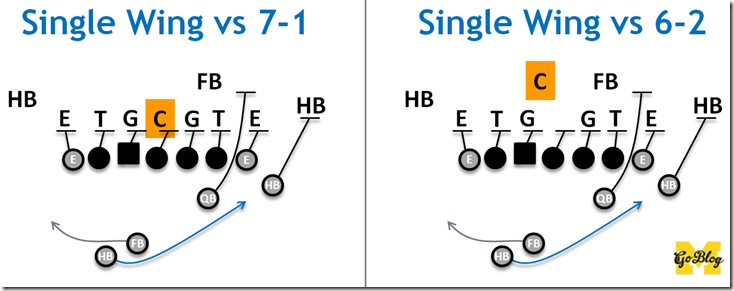

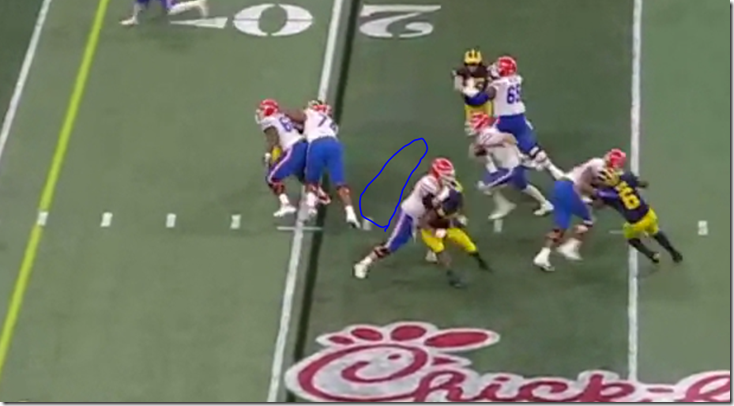

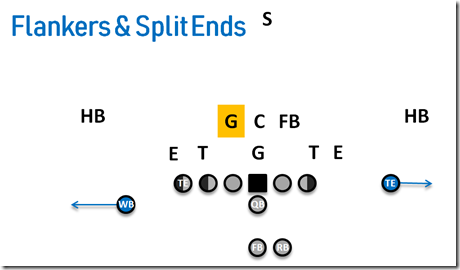

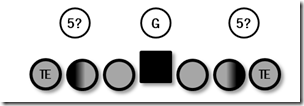
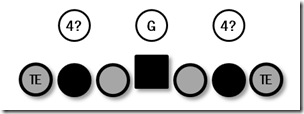
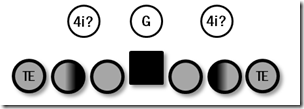
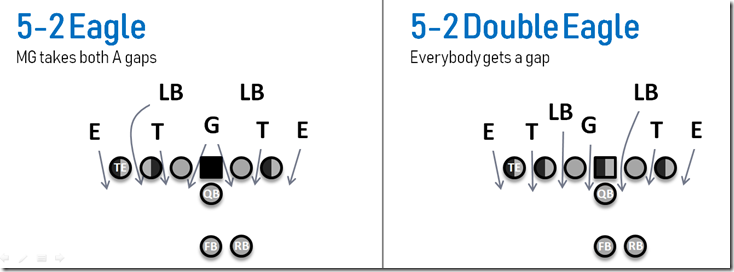
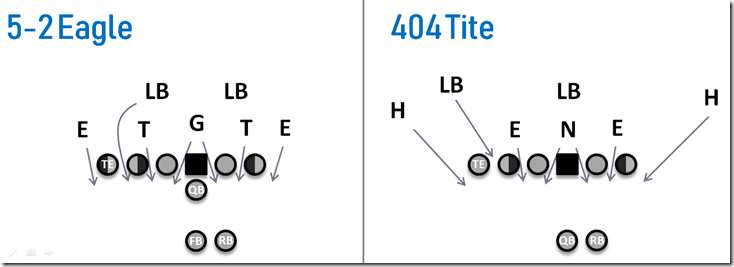
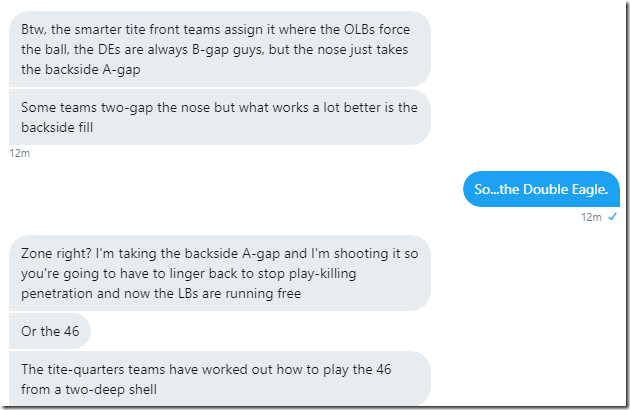
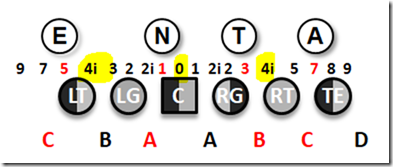
:no_upscale()/cdn.vox-cdn.com/uploads/chorus_asset/file/10242393/4i_3_over_2_in_A_gap.jpg)
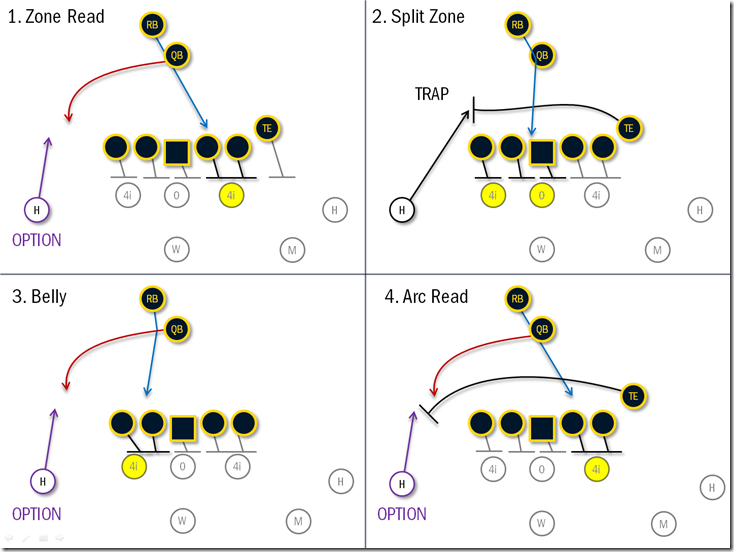
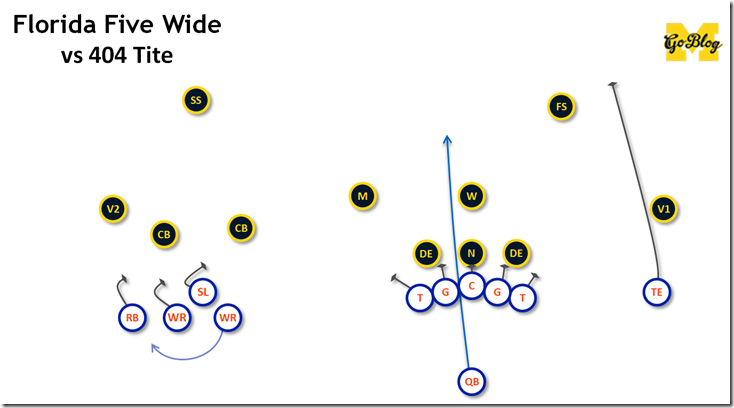
:no_upscale()/cdn.vox-cdn.com/uploads/chorus_asset/file/13728472/key.jpg)
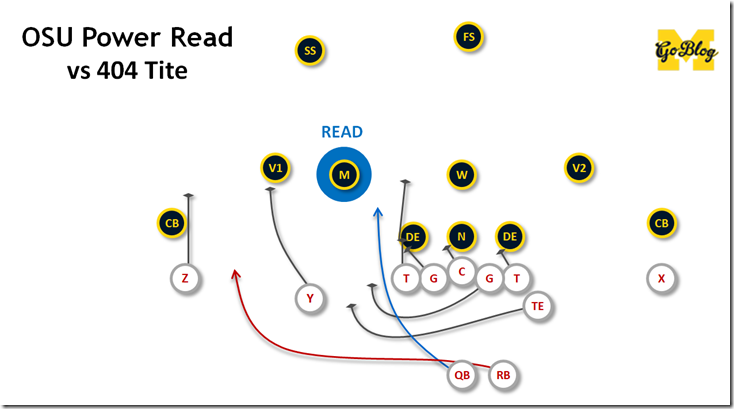
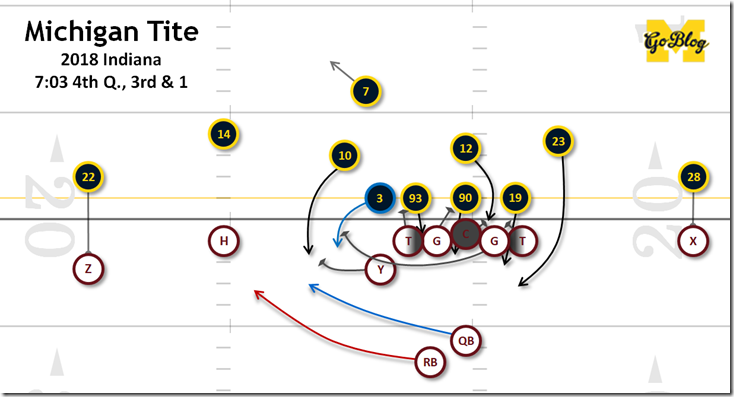
Comments